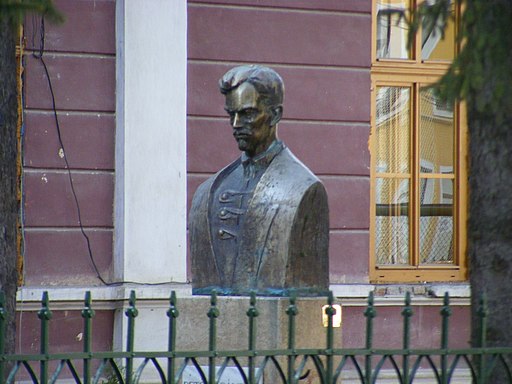Bust of General Gál Sándor
Bust of General Gál Sándor
Original function:
statue / memorial / relief
Current function:
statue / memorial / relief
Historical Hungarian county:
Csík
GPS coordinates:
46.3637267044, 25.801496887
History
Gál Sándor was born in Csíkszentgyörgy in 1817. In 1848 he participated in the organisation of the National Guard. Together with Klapka György and Hajnik Károly, Prime Minister Batthyány Lajos sent him to Transylvania to mobilise the Székely army in support of the Hungarian government. He became Chief of Staff of the Székely army. After the Transylvanian commander-in-chief Puchner Antal had disobeyed the Hungarian government and pushed the Hungarian troops out of Transylvania, the Székely army was forced back to Háromszék. Gál Sándor was the organizer and commander of the Székely troops in the fighting in Háromszék. After the liberation of Székelyland, in January 1849, General Bem József promoted him to the rank of colonel and entrusted him with the further organisation of the Székely forces. On 4 February he was attacked by the Tsarist detachment and was defeated in the battle of Szászhermány.
By March, he had raised a regular corps of 10,000 men and took part in the summer campaign as commander of this unit, known as the Székelyland Division. On 19 and 20 June he took part in heavy fighting at the Tömösi Pass. On 2 July, Gál's Székely division attacked the Tsarist troops left behind to secure Székelyland between Kökös and Uzon. It was in this battle that the artillery commander of the Székely division, Gábor Áron, was killed. When the enemy entered Székelyland, he retreated with his troops to Csíkszereda. In mid-July, together with General Bem, who had arrived there, he launched a counterattack and on 23 July he fought a successful battle with the 15,000-strong Imperial corps near Sepsisentgyörgy. On 29 July he was promoted to general, but only later, in emigration, did he learn of this. He was decisively defeated by the Austro-Russian forces at the Battle of Nyergestető on 1 August. With this defeat, the whole of Székelyland fell into the hands of the enemy. With the rest of his army he joined Colonel Kazinczy's troops in Kolozsvár, but after Kazinczy surrendered at Zsibó on 24 August he hid for a while in the marshes around Szatmár, and then managed to escape abroad in the spring of 1850.
He was active in Hamburg and London, maintaining close contact with the revolutionaries forced into exile, then Kossuth Lajos sent him to Constantinople and entrusted him with the military leadership of the Transylvanian liberation movement. In November 1851 he appointed him commander-in-chief of the so-called Transylvanian liberation army. He took part in the preparation of the independence movement led by Makk József, Jubál Károly and May János.
{"item":"sight","set":{"sightId":2223,"townId":82,"active":1,"name_LO":"","address":"Temesv\u00e1ri \u00fat","mapdata":"1|827|591","gps_lat":"46.3637267044","gps_long":"25.8014968870","religion":0,"oldtype":"38","newtype":"38","homepage":"https:\/\/www.kozterkep.hu\/16181\/gal-sandor-tabornok-mellszobra","openinghours":"","muemlekemlink":"","csemadoklink":"","picture":"\u003Ca title=\u0022Szabi237, CC BY 3.0 <https:\/\/creativecommons.org\/licenses\/by\/3.0>, via Wikimedia Commons\u0022 href=\u0022https:\/\/commons.wikimedia.org\/wiki\/File:Pet%C5%91fi_S%C3%A1ndor%27s_statue.JPG\u0022\u003E\u003Cimg width=\u0022512\u0022 alt=\u0022Pet\u0151fi S\u00e1ndor's statue\u0022 src=\u0022https:\/\/upload.wikimedia.org\/wikipedia\/commons\/thumb\/c\/c1\/Pet%C5%91fi_S%C3%A1ndor%27s_statue.JPG\/512px-Pet%C5%91fi_S%C3%A1ndor%27s_statue.JPG\u0022\u003E\u003C\/a\u003E","picture_ref":"\u003Ca href=\u0022https:\/\/commons.wikimedia.org\/wiki\/File:Pet%C5%91fi_S%C3%A1ndor%27s_statue.JPG\u0022\u003ESzabi237\u003C\/a\u003E, \u003Ca href=\u0022https:\/\/creativecommons.org\/licenses\/by\/3.0\u0022\u003ECC BY 3.0\u003C\/a\u003E, via Wikimedia Commons","name":"Bust of General G\u00e1l S\u00e1ndor","note":"","history":"G\u00e1l S\u00e1ndor was born in Cs\u00edkszentgy\u00f6rgy in 1817. In 1848 he participated in the organisation of the National Guard. Together with Klapka Gy\u00f6rgy and Hajnik K\u00e1roly, Prime Minister Batthy\u00e1ny Lajos sent him to Transylvania to mobilise the Sz\u00e9kely army in support of the Hungarian government. He became Chief of Staff of the Sz\u00e9kely army. After the Transylvanian commander-in-chief Puchner Antal had disobeyed the Hungarian government and pushed the Hungarian troops out of Transylvania, the Sz\u00e9kely army was forced back to H\u00e1romsz\u00e9k. G\u00e1l S\u00e1ndor was the organizer and commander of the Sz\u00e9kely troops in the fighting in H\u00e1romsz\u00e9k. After the liberation of Sz\u00e9kelyland, in January 1849, General Bem J\u00f3zsef promoted him to the rank of colonel and entrusted him with the further organisation of the Sz\u00e9kely forces. On 4 February he was attacked by the Tsarist detachment and was defeated in the battle of Sz\u00e1szherm\u00e1ny.@\nBy March, he had raised a regular corps of 10,000 men and took part in the summer campaign as commander of this unit, known as the Sz\u00e9kelyland Division. On 19 and 20 June he took part in heavy fighting at the T\u00f6m\u00f6si Pass. On 2 July, G\u00e1l's Sz\u00e9kely division attacked the Tsarist troops left behind to secure Sz\u00e9kelyland between K\u00f6k\u00f6s and Uzon. It was in this battle that the artillery commander of the Sz\u00e9kely division, G\u00e1bor \u00c1ron, was killed. When the enemy entered Sz\u00e9kelyland, he retreated with his troops to Cs\u00edkszereda. In mid-July, together with General Bem, who had arrived there, he launched a counterattack and on 23 July he fought a successful battle with the 15,000-strong Imperial corps near Sepsisentgy\u00f6rgy. On 29 July he was promoted to general, but only later, in emigration, did he learn of this. He was decisively defeated by the Austro-Russian forces at the Battle of Nyergestet\u0151 on 1 August. With this defeat, the whole of Sz\u00e9kelyland fell into the hands of the enemy. With the rest of his army he joined Colonel Kazinczy's troops in Kolozsv\u00e1r, but after Kazinczy surrendered at Zsib\u00f3 on 24 August he hid for a while in the marshes around Szatm\u00e1r, and then managed to escape abroad in the spring of 1850.@\nHe was active in Hamburg and London, maintaining close contact with the revolutionaries forced into exile, then Kossuth Lajos sent him to Constantinople and entrusted him with the military leadership of the Transylvanian liberation movement. In November 1851 he appointed him commander-in-chief of the so-called Transylvanian liberation army. He took part in the preparation of the independence movement led by Makk J\u00f3zsef, Jub\u00e1l K\u00e1roly and May J\u00e1nos. ","town":{"townId":82,"name_HU":"Cs\u00edkszereda","name_LO":"Miercurea Ciuc","seolink":"csikszereda-miercurea-ciuc","oldcounty":42,"country":4}},"language":"en","region":"romania","regionid":4,"offer":[],"gallery":false,"album":false}

